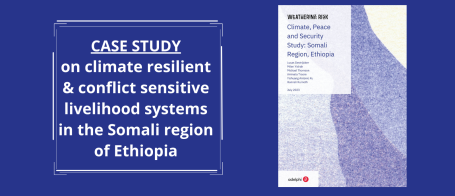Climate, Peace and Security Study: Somali Region, Ethiopia
Download the full report here.
The Somali Region, located in south-eastern Ethiopia and bordering Somalia, is particularly vulnerable to climate impacts and related risks to peace and human security. Its climate has already become drier, hotter and more unpredictable over the past years, and is expected to worsen in the future. The region faces further increase in the average annual temperature and the number of ‘very hot days’ (over 35°C), more rainfall variability, heightening the risk of extended periods of drought, more heavy precipitation, which can lead to more water run-off and increasing the risk of flash floods and river floods and changing weather patterns, increasing the risk of disease outbreaks and pests such as the desert locust.
These climate impacts bring about a series of related security risks in the Somali Region. Based on the combined analysis of both contextual and climate-related factors, this study presents five key climate insecurity pathways, through which climate change and environmental pressures can compound risks to peace and security. It then identifies entry points and priorities as guidance for future programming in the region.
This climate, peace and security study serves as one of the case studies undertaken during the adelphi-WFP learning collaboration. The Somali Region was selected because of its particular vulnerability to climate impacts and related risks to peace and human security.
Share on


